+ Open data
Open data
- Basic information
Basic information
| Entry | Database: PDB / ID: 6sz9 | ||||||
|---|---|---|---|---|---|---|---|
| Title | Type IV Coupling Complex (T4CC) from L. pneumophila. | ||||||
 Components Components |
| ||||||
 Keywords Keywords | MEMBRANE PROTEIN / Protein Complex / Secretion / Secretion systems / Gram-negative bacteria / type 4 secretion system / T4SS / coupling protein / T4CC / DotL / DotM / DotN / DotY / DotZ | ||||||
| Function / homology |  Function and homology information Function and homology information | ||||||
| Biological species |  | ||||||
| Method | ELECTRON MICROSCOPY / single particle reconstruction / cryo EM / Resolution: 3.7 Å | ||||||
 Authors Authors | Mace, K. / Meir, A. / Lukoyanova, N. / Waksman, G. | ||||||
| Funding support |  United Kingdom, 1items United Kingdom, 1items
| ||||||
 Citation Citation |  Journal: Nat Commun / Year: 2020 Journal: Nat Commun / Year: 2020Title: Mechanism of effector capture and delivery by the type IV secretion system from Legionella pneumophila. Authors: Amit Meir / Kevin Macé / Natalya Lukoyanova / David Chetrit / Manuela K Hospenthal / Adam Redzej / Craig Roy / Gabriel Waksman /    Abstract: Legionella pneumophila is a bacterial pathogen that utilises a Type IV secretion (T4S) system to inject effector proteins into human macrophages. Essential to the recruitment and delivery of ...Legionella pneumophila is a bacterial pathogen that utilises a Type IV secretion (T4S) system to inject effector proteins into human macrophages. Essential to the recruitment and delivery of effectors to the T4S machinery is the membrane-embedded T4 coupling complex (T4CC). Here, we purify an intact T4CC from the Legionella membrane. It contains the DotL ATPase, the DotM and DotN proteins, the chaperone module IcmSW, and two previously uncharacterised proteins, DotY and DotZ. The atomic resolution structure reveals a DotLMNYZ hetero-pentameric core from which the flexible IcmSW module protrudes. Six of these hetero-pentameric complexes may assemble into a 1.6-MDa hexameric nanomachine, forming an inner membrane channel for effectors to pass through. Analysis of multiple cryo EM maps, further modelling and mutagenesis provide working models for the mechanism for binding and delivery of two essential classes of Legionella effectors, depending on IcmSW or DotM, respectively. | ||||||
| History |
|
- Structure visualization
Structure visualization
| Movie |
 Movie viewer Movie viewer |
|---|---|
| Structure viewer | Molecule:  Molmil Molmil Jmol/JSmol Jmol/JSmol |
- Downloads & links
Downloads & links
- Download
Download
| PDBx/mmCIF format |  6sz9.cif.gz 6sz9.cif.gz | 246.5 KB | Display |  PDBx/mmCIF format PDBx/mmCIF format |
|---|---|---|---|---|
| PDB format |  pdb6sz9.ent.gz pdb6sz9.ent.gz | 189.6 KB | Display |  PDB format PDB format |
| PDBx/mmJSON format |  6sz9.json.gz 6sz9.json.gz | Tree view |  PDBx/mmJSON format PDBx/mmJSON format | |
| Others |  Other downloads Other downloads |
-Validation report
| Summary document |  6sz9_validation.pdf.gz 6sz9_validation.pdf.gz | 1.3 MB | Display |  wwPDB validaton report wwPDB validaton report |
|---|---|---|---|---|
| Full document |  6sz9_full_validation.pdf.gz 6sz9_full_validation.pdf.gz | 1.3 MB | Display | |
| Data in XML |  6sz9_validation.xml.gz 6sz9_validation.xml.gz | 49.9 KB | Display | |
| Data in CIF |  6sz9_validation.cif.gz 6sz9_validation.cif.gz | 74.1 KB | Display | |
| Arichive directory |  https://data.pdbj.org/pub/pdb/validation_reports/sz/6sz9 https://data.pdbj.org/pub/pdb/validation_reports/sz/6sz9 ftp://data.pdbj.org/pub/pdb/validation_reports/sz/6sz9 ftp://data.pdbj.org/pub/pdb/validation_reports/sz/6sz9 | HTTPS FTP |
-Related structure data
| Related structure data |  10350MC M: map data used to model this data C: citing same article ( |
|---|---|
| Similar structure data |
- Links
Links
- Assembly
Assembly
| Deposited unit | 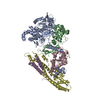
|
|---|---|
| 1 |
|
- Components
Components
-Protein , 5 types, 5 molecules ABCDE
| #1: Protein | Mass: 87600.992 Da / Num. of mol.: 1 Source method: isolated from a genetically manipulated source Details: C-terminal Streptavidin tag / Source: (gene. exp.)   |
|---|---|
| #2: Protein | Mass: 43858.879 Da / Num. of mol.: 1 Source method: isolated from a genetically manipulated source Source: (gene. exp.)   |
| #3: Protein | Mass: 23762.971 Da / Num. of mol.: 1 Source method: isolated from a genetically manipulated source Source: (gene. exp.)   |
| #4: Protein | Mass: 33887.512 Da / Num. of mol.: 1 Source method: isolated from a genetically manipulated source Source: (gene. exp.)   |
| #5: Protein | Mass: 25550.957 Da / Num. of mol.: 1 Source method: isolated from a genetically manipulated source Source: (gene. exp.)   |
-Non-polymers , 1 types, 1 molecules 
| #6: Chemical | ChemComp-ZN / |
|---|
-Details
| Has ligand of interest | Y |
|---|
-Experimental details
-Experiment
| Experiment | Method: ELECTRON MICROSCOPY |
|---|---|
| EM experiment | Aggregation state: PARTICLE / 3D reconstruction method: single particle reconstruction |
- Sample preparation
Sample preparation
| Component | Name: Coupling complex of the type IV secretion system / Type: COMPLEX / Entity ID: #1-#5 / Source: RECOMBINANT | |||||||||||||||||||||||||
|---|---|---|---|---|---|---|---|---|---|---|---|---|---|---|---|---|---|---|---|---|---|---|---|---|---|---|
| Molecular weight | Experimental value: NO | |||||||||||||||||||||||||
| Source (natural) | Organism:  | |||||||||||||||||||||||||
| Source (recombinant) | Organism:  | |||||||||||||||||||||||||
| Buffer solution | pH: 8 | |||||||||||||||||||||||||
| Buffer component |
| |||||||||||||||||||||||||
| Specimen | Conc.: 0.175 mg/ml / Embedding applied: NO / Shadowing applied: NO / Staining applied: NO / Vitrification applied: YES | |||||||||||||||||||||||||
| Specimen support | Grid material: GOLD / Grid type: UltrAuFoil | |||||||||||||||||||||||||
| Vitrification | Instrument: FEI VITROBOT MARK IV / Cryogen name: ETHANE / Humidity: 94 % |
- Electron microscopy imaging
Electron microscopy imaging
| Experimental equipment |  Model: Titan Krios / Image courtesy: FEI Company |
|---|---|
| Microscopy | Model: FEI TITAN KRIOS |
| Electron gun | Electron source:  FIELD EMISSION GUN / Accelerating voltage: 300 kV / Illumination mode: OTHER FIELD EMISSION GUN / Accelerating voltage: 300 kV / Illumination mode: OTHER |
| Electron lens | Mode: OTHER |
| Image recording | Electron dose: 54 e/Å2 / Detector mode: COUNTING / Film or detector model: GATAN K2 SUMMIT (4k x 4k) |
| Image scans | Movie frames/image: 48 |
- Processing
Processing
| EM software |
| ||||||||||||||||||||||||||||||||||||
|---|---|---|---|---|---|---|---|---|---|---|---|---|---|---|---|---|---|---|---|---|---|---|---|---|---|---|---|---|---|---|---|---|---|---|---|---|---|
| CTF correction | Type: PHASE FLIPPING AND AMPLITUDE CORRECTION | ||||||||||||||||||||||||||||||||||||
| Symmetry | Point symmetry: C1 (asymmetric) | ||||||||||||||||||||||||||||||||||||
| 3D reconstruction | Resolution: 3.7 Å / Resolution method: FSC 0.143 CUT-OFF / Num. of particles: 219593 / Algorithm: FOURIER SPACE / Num. of class averages: 2 / Symmetry type: POINT |
 Movie
Movie Controller
Controller



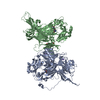
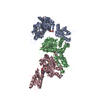

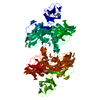


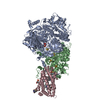
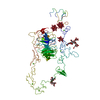
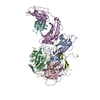
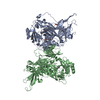
 PDBj
PDBj

